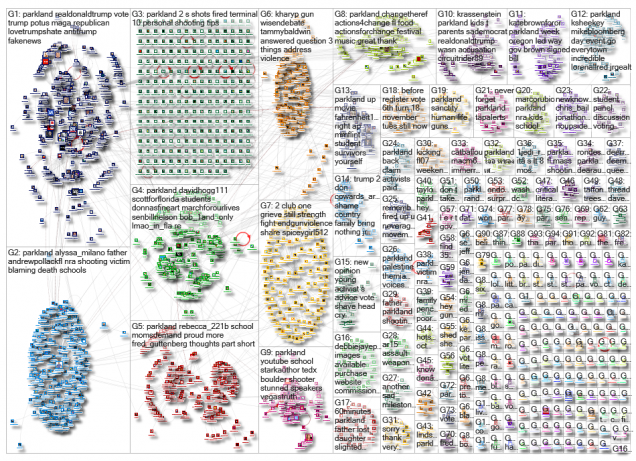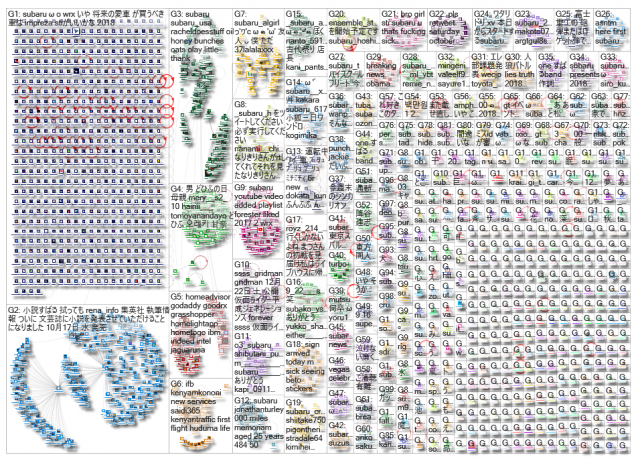
Graph 1 Source: https://nodexlgraphgallery.org/Pages/Graph.aspx?graphID=171397
The first graph I found contains Twitter users who were either replied to or mentioned in the topic of #Parkland. #Parkland was tied to the shooting tragedy at the Stoneman Douglas High School in Parkland, Florida, on February 14, 2018, that resulted in the death of 17 people. The NodeXL graph contains 2,912 Twitter users, and the date range for the tweets is from September 30, 2018, to October 14, 2018. Since the tragedy occurred in February and these tweets were collected more recently, some of the topics and conversations can be extracted from the top hashtags, top URLs, and key influencers of different groups.
The #Parkland network fits into the community cluster type based on Marc Smith’s six types of network structure, where many small and medium groups that have moderate connections and some isolates and unconnected participants could be observed. According to Smith, community clusters consist of multiple smaller groups that can form around a few hubs, each with its own audience, influencers, and sources of information (Smith, 2014, p. 3), which is the case here for the #Parkland network. While the topic in group 1 was related to voting, President Trump, and Republicans, the topics in group 2 were about making a difference and liberals. Thus, it is not surprising to see that some of the top hashtags in group 1 included #parkland, #vote, #potus, and #maga; and group 2 included #neverforget, #enoughisenough, and #msdstrong, among others.
The top replied-to users also vary across different groups. For example, in group 1, the top replied-to users include @thehill, @realdonaldtrump, @foxnews, and @robertwruncie. By contrast, the top replied-to users in group 2 include @alyssa_milano, @andrewpollackfl, and @chuckwoolery. In addition, people used the same hashtag, #Parkland, when talking about different topics in different groups. For example, some people talked about the newly released documentary titled Parkland: Inside Building 12 along with the hashtag #endgunviolence. Others used the same hashtag in companion with #lovetrumpshate. Something worth mentioning here is the influencers in different groups. In group 2, @alyssa_milano, the American actress and liberal activist who attended the Actions4Change event to support #Parkland and tweeted about the event, is the key influencer. She has about 3.5 million followers on Twitter and about 52K tweets, and few hubs have been created around her image that form into their own community. Group 1 consists of some major news outlets, such as Fox News, The Hill, and CNN, along with the president’s own Twitter account.

Graph 2 Source: https://nodexlgraphgallery.org/Pages/Graph.aspx?graphID=171347
The second graph consists of tweets that contain the Japanese automobile manufacturer “Subaru.” The NodeXL graph contains a network of 3,141 Twitter users in the date range between October 12, 2018, and October 13, 2018. The topic of the Subaru network fits into the brand cluster type based on Smith’s six types of network structure, where many small groups that have few connections and many isolates and unconnected participants could be observed. Although it is less likely for a brand cluster to have many connections between participants, there would be a greater number of isolators. The Subaru topic network still consists of some small groups that are formed by authoritative accounts like some popular magazines and influencers, such as @shosetsusubaru and @rena_info.
I think the #Parkland social network on Twitter illustrates a good example drawn from Lee Rainie and Barry Wellman’s argument about the sense of empowerment discussed in the Networked Creators chapter. The network makes it possible to connect complete strangers to one another, and “a sense of shared purpose arose and communities of mutual trust and assistance developed” (Rainie & Wellman, 2014, p. 208). Individuals who choose to use the same hashtags when discussing a topic not only express themselves but also feel a sense of empowerment through the community who may share the same values with themselves by making their voices heard. Smith also explains the importance of forming community clusters, where multiple conversations about one subject may develop diverse angles based on its relevance to different audiences, thus revealing diversified perspectives (Smith, Rainie, Shneiderman, & Himelboim, 2014, p. 3). However, Smyrnaios’s argument that internet oligopoly takes the infomediary roles to control the sources of information may change the network type because there would be agenda setters who influence the formation of groups to discuss opinions that are relevant to their agenda. In the end, while the created network makes it possible for other people to hear other voices, infomediation still needs to be considered when discussing social media topics.
References
Rainie, H., & Wellman, Barry. (2012). Networked: The new social operating system. Cambridge, Mass.: MIT Press.
Smith, M. A., Rainie, L., Shneiderman, B., & Himelboim, I. (2014). Mapping Twitter topic networks: From polarized crowds to community clusters. Pew Research Center. Retrieved from http://www.pewinternet.org/2014/02/20/mapping-twitter-topic-networks-from-polarized-crowds-to-community-clusters/
Smyrnaios, N. (2018). Internet oligopoly: The corporate takeover of our digital world. Bingley: Emerald Group Publishing.